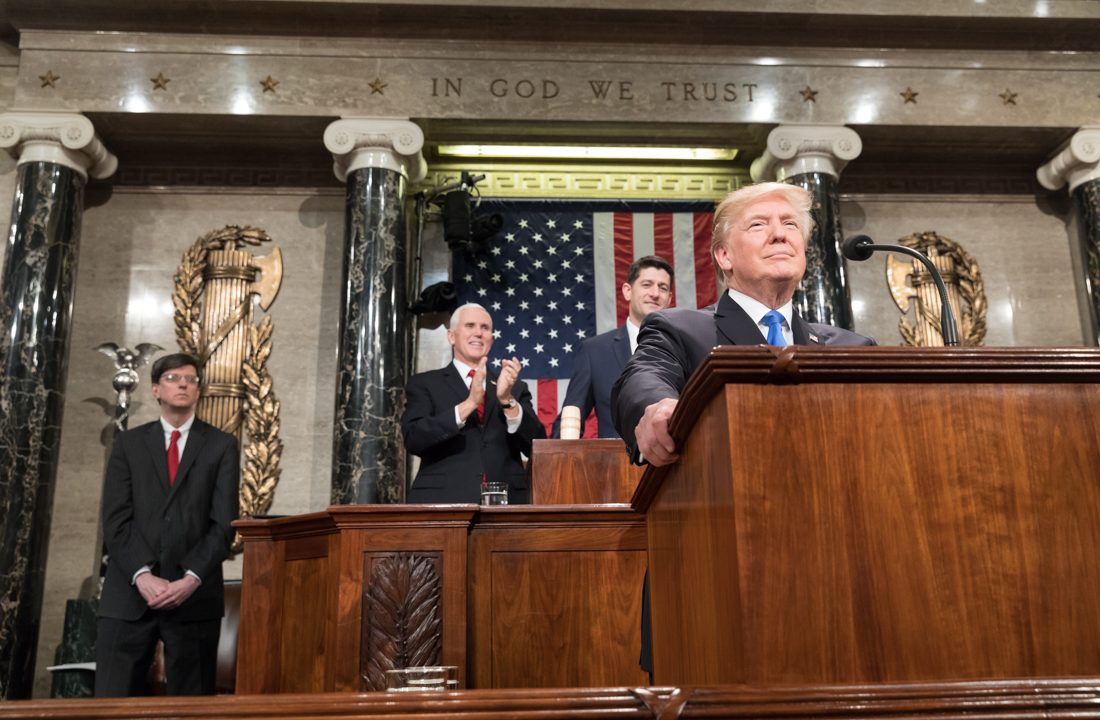On Tuesday, January 30, President Donald Trump gave his first State of the Union address. The speech was filled with promises of compromise between the Democrats and the Republicans, along with plans for a future immigration policy and infrastructural improvements. Trump also trumpeted the economic improvements that have come about during his administration.
Bipartisanship
Towards the beginning of his address, Trump called for Republicans and Democrats to “set aside [their] differences, and unify to help the American people.” Given the recent government shutdown, caused by massive disagreements over the construction of a border wall, this goal of bipartisanship seems a little far-fetched.
Immigration Policy
In his speech, President Trump established his “four pillars” of immigration policy. Those pillars are as follows:
- Establish a path to citizenship: Trump stated that under his new plan, “those who meet education and work requirements, and show good moral character, will be able to become full citizens of the United States” after twelve years. This contradicts his earlier calls to deport all illegal immigrants currently in the United States.
- Secure the border: Trump wishes to “secure the border” by building a wall on the Mexican-American boundary, closing immigration law loopholes, and ending the “catch and release,” in which illegal immigrants arrested within the United States are released following detention and prior to their hearing.
- End the green card lottery: President Trump wishes to end the Obama-era program in which green cards were issued in a lottery-based system, and instead replace it with a merit-based system. However, the lottery system isn’t exactly random. All entrants into the lottery must have at least a high school education and two years of work experience in the past five years. Even then, those awarded green cards must go through a security and background check.
- End of chain migration: Trump wishes to end the ability of immigrants to “chain migrate” in which green card holders can sponsor prospective immigrant family members’ entrance into the United States. While, yes, green card holders can sponsor their family members’ entrance to the US, that sponsorship does not immediately grant those family members the ability to enter the country.
Infrastructure
Donald Trump asked Congress to set aside $1.5 trillion for rebuilding and enhancing America’s infrastructure, promising the American people “new, gleaming roads.” That’s a massive promise, and one that I hope that the Trump administration will fulfill, considering the United States ranks 25th in terms of infrastructure according to a 2013 World Economic Forum report.
Education
Oddly enough, President Trump made little to no mention of his plans for the American educational system, aside from promises of increased funding for job training programs and vocational schools. Stranger still is that Trump’s May 2017 proposed budget sought 40% cuts in job training programs.
Economy
President Trump harped on the economic jump the United States of America has made since he took office. To his credit, the stock market has broken record after record since January 2017. In his speech, he told the American people that “after years of wage stagnation, we are finally seeing rising wages.” While this is true, that growth is slower than in the second half of President Obama’s second term, and still lower than the growth seen during the years prior to the 2008 recession according to the Federal Reserve’s Atlanta branch.
Health
I may disagree with President Trump on many things, but I agree with him that prescription drug prices in the United States are absurdly high. While this has been an issue for decades, it really reached the public eye when Turing Pharmaceuticals raised the price of daraprim, a drug that helps prop up the immune systems of AIDS patients, from $13.50 per pill to $750 per pill in 2015. While I support the President in this endeavor, I’m cautious that he won’t put his money where his mouth is, and actively fight rising drug price, as he has made and broken that promise before.
When Donald Trump spoke in the House chamber on January 30, we saw a side to him we rarely ever see. Few of his statements were inflammatory at face value, and he spoke with a tone much more civil than we’re accustomed to. However, as he’s shown in the past, Donald Trump is unpredictable. We’ll have to wait and see if he actually does seek to work with the Democrats instead of against him, if he actually does get a infrastructure package passed, and if he will make a dent in skyrocketing pharmaceutical prices.

Leave a Reply